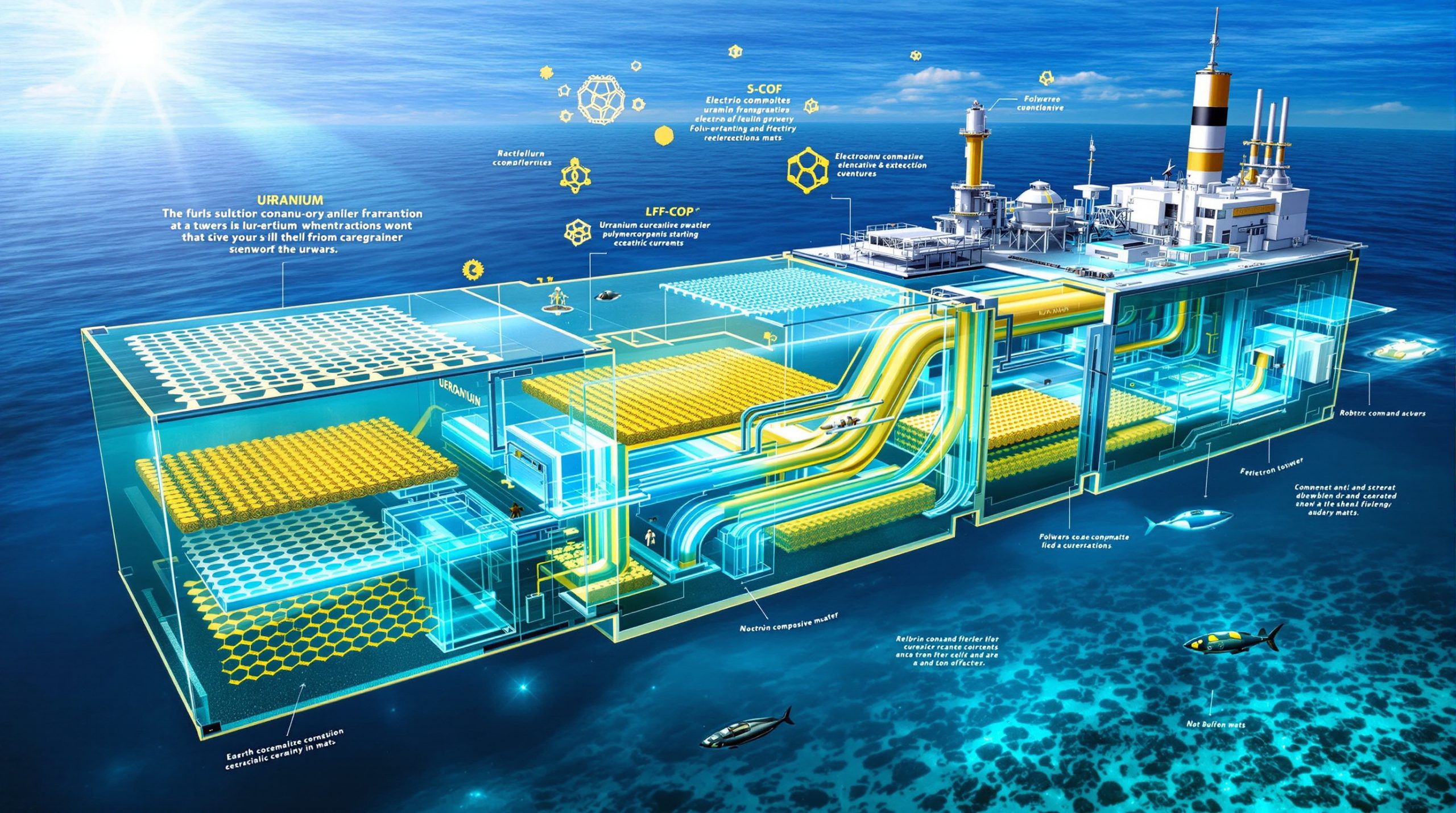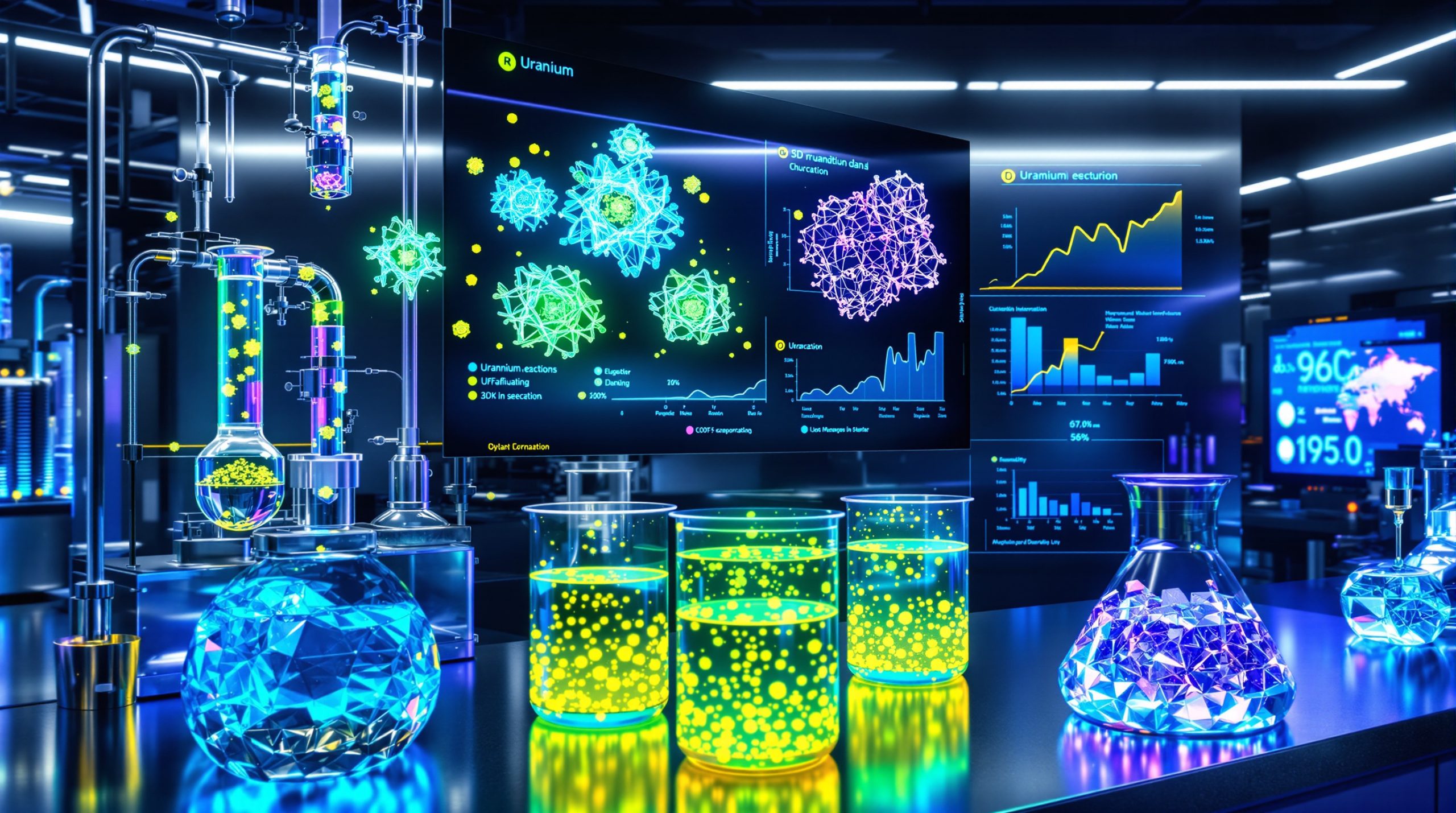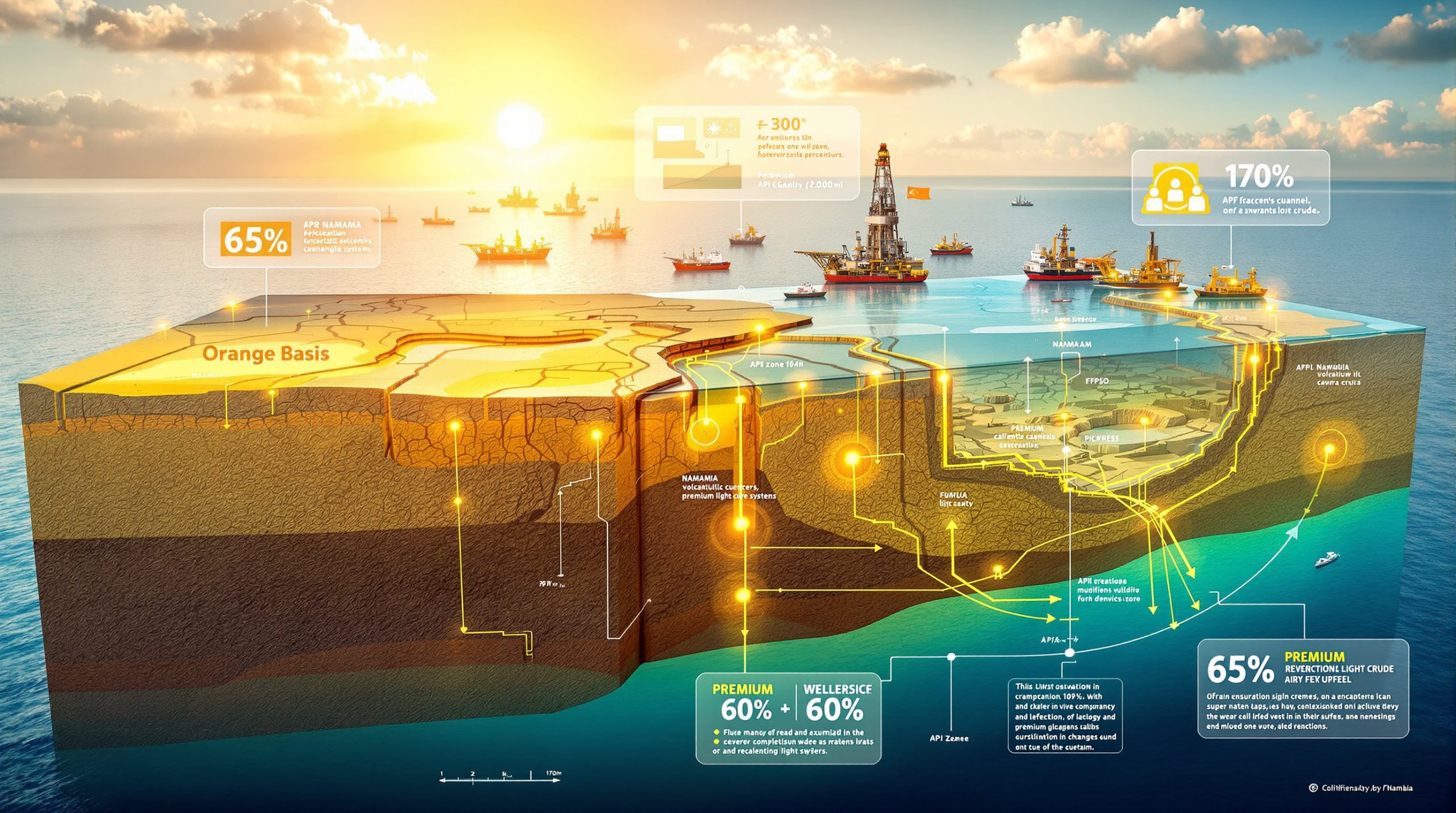The vast oceans surrounding our planet represent an untapped uranium reservoir of extraordinary magnitude. While conventional mining operations extract uranium from terrestrial deposits containing mere millions of tons, seawater holds an estimated 4.5 billion tons of dissolved uranium. This marine resource dwarfs all known land-based reserves by more than a thousandfold, yet remains largely inaccessible due to complex technical challenges that have puzzled engineers for decades.
The concentration paradox defines the central obstacle: uranium exists in seawater at just 3 micrograms per liter, requiring the processing of enormous volumes to yield meaningful quantities. Despite this dilution, the sheer scale of ocean water makes extracting uranium from seawater a potentially transformative technology for nuclear fuel security, particularly as uranium market dynamics continue to evolve in response to growing nuclear energy demands.
Understanding Seawater Uranium: The World's Largest Untapped Nuclear Resource
Uranium Concentration and Distribution in Ocean Waters
The uranium dissolved in Earth's oceans represents a resource base that exceeds terrestrial uranium reserves by orders of magnitude. Current estimates place the global inventory at approximately 4.5 billion tons, compared to roughly 3.7 million tons in known land-based deposits. This massive difference stems from billions of years of geological weathering processes that have leached uranium from continental rocks and concentrated it in seawater.
Ocean uranium maintains remarkably consistent concentrations across different basins. The Atlantic, Pacific, and Indian Oceans all contain uranium at approximately 3.3 parts per billion, with minimal variation between surface and deep waters. This uniformity results from uranium's long residence time in seawater, estimated at 400,000 to 500,000 years, which allows thorough mixing throughout the global ocean system.
Geographic distribution patterns reveal that uranium concentrations remain stable across various ocean depths and latitudes. Unlike many dissolved metals that show significant vertical or regional variations, uranium maintains consistent levels from tropical to polar waters, making any accessible ocean location potentially viable for extraction operations.
The dissolved uranium exists primarily as uranyl carbonate complexes, which remain stable in seawater's alkaline environment. This chemical form presents both opportunities and challenges for extraction technologies, as the complexes resist traditional precipitation methods while remaining accessible to specialised adsorption materials.
Why Traditional Mining Methods Cannot Access This Resource
Conventional uranium extraction relies on concentrated ore deposits where uranium comprises 0.1% to 20% of the total material. These terrestrial sources allow economically viable extraction through established mining, milling, and processing techniques that have been refined over decades. In contrast, seawater's 0.0003% uranium concentration creates fundamentally different technical and economic requirements.
Physical extraction challenges begin with the enormous volumes required. Producing one kilogram of uranium from seawater theoretically requires processing 330 million litres of ocean water. This scale demands completely different infrastructure compared to conventional mining operations that process thousands of tons of ore to produce similar uranium quantities.
Traditional chemical processing methods prove inadequate for seawater applications. Conventional uranium mills use acid or alkaline leaching to dissolve uranium from crushed ore, followed by solvent extraction or ion exchange purification. However, these processes cannot selectively extract uranium from seawater's complex mixture of dissolved salts, organic matter, and competing ions.
The marine environment introduces additional complications absent from land-based operations. Saltwater corrosion, biofouling, wave action, and deep-ocean pressures create engineering challenges that terrestrial mining equipment cannot address. These factors require entirely new approaches to materials science, deployment strategies, and maintenance protocols.
What Are the Main Technical Approaches to Uranium Seawater Extraction?
Passive Adsorption Systems
Passive extraction systems rely on natural ocean currents and water movement to bring uranium-bearing seawater into contact with specialised adsorbent materials. These systems deploy large arrays of adsorbent materials in high-current areas, allowing the ocean's natural energy to drive the extraction process without external power requirements.
Material deployment strategies focus on maximising water contact while minimising drag forces that could damage or displace extraction equipment. Engineers design flexible braided systems that can flex with ocean currents while maintaining optimal geometry for uranium capture. These deployments often resemble underwater forests, with vertical arrays extending through the water column to intercept different current layers.
Contact time optimisation represents a critical design parameter for passive systems. Adsorbent materials require sufficient residence time to capture uranium ions from passing water, but extended deployment periods increase biofouling risks and material degradation. Furthermore, current research suggests optimal deployment cycles of 30 to 60 days before material recovery and processing.
Scaling considerations for industrial operations involve deploying thousands of adsorbent units across ocean areas spanning several square kilometres. These massive installations require careful planning to avoid interference with shipping lanes, fishing grounds, and marine ecosystems while maintaining accessibility for regular maintenance and material recovery.
Active Electrochemical Extraction Methods
Electrochemical extraction employs electrical fields to concentrate uranium ions from seawater through selective attraction and deposition processes. These active systems can achieve higher extraction rates than passive methods but require substantial energy inputs that must be balanced against uranium yield economics.
Electrode-based uranium concentration techniques utilise specially designed electrode materials that selectively attract uranyl ions while repelling other seawater components. Advanced electrode configurations create localised environments where uranium concentrates to levels 100 to 1,000 times higher than ambient seawater concentrations, enabling more efficient recovery.
Power requirements for electrochemical systems typically range from 5 to 15 kilowatt-hours per gram of recovered uranium, depending on system efficiency and operating conditions. These energy demands necessitate either connection to offshore wind installations or deployment of floating nuclear reactors to provide economically viable power sources.
Continuous processing capabilities distinguish electrochemical methods from batch-oriented passive systems. These installations can operate continuously as long as power remains available, potentially achieving uranium recovery rates of several kilograms per day from properly sized installations.
Hybrid Extraction Technologies
Hybrid systems combine passive adsorption with active concentration methods to optimise both energy efficiency and extraction rates. These integrated approaches use passive pre-concentration followed by electrochemical finishing stages to achieve superior performance compared to either method alone.
Multi-stage purification processes incorporate sequential treatment steps that progressively concentrate uranium while removing competing ions and organic contaminants. Initial stages may use broad-spectrum adsorbents to capture uranyl complexes, while subsequent stages employ increasingly selective materials to achieve nuclear-grade purity.
Integration with existing offshore infrastructure presents opportunities to reduce deployment costs and energy requirements. Oil platforms, offshore wind installations, and aquaculture facilities could potentially host uranium extraction systems, sharing power generation, maintenance access, and environmental monitoring capabilities.
Which Materials Achieve the Highest Uranium Extraction Rates?
Sulfonic Covalent Organic Frameworks (S-COFs)
Recent advances in materials science have produced sulfonic acid-functionalised covalent organic frameworks that demonstrate unprecedented uranium extraction performance. These engineered materials achieve uranium uptake rates exceeding 31.5 milligrams per gram of sorbent per day under optimal conditions, representing significant improvements over previous generation materials.
Molecular structure design focuses on creating precisely sized binding sites that accommodate uranyl carbonate complexes while excluding competing ions. The sulfonic acid functional groups provide strong electrostatic attraction for positively charged uranyl species, while the framework's geometric structure prevents access by larger hydrated ions like calcium and magnesium.
| Material Type | Extraction Rate (mg/g/day) | Selectivity Ratio | Reusability Cycles |
|---|---|---|---|
| S-COFs | 31.5 | 1000:1 vs competing ions | 50+ |
| Metal-Organic Frameworks | 18-25 | 500:1 | 30-40 |
| Layered Double Hydroxides | 12-20 | 200:1 | 25-35 |
Geometric stacking configurations significantly influence extraction performance. AA-stacking arrangements, where framework layers align directly, create uniform pore channels that facilitate rapid uranium diffusion. In contrast, AB-stacking patterns produce tortuous pathways that slow mass transfer but may enhance selectivity through extended contact time.
Metal-Organic Frameworks (MOFs) for Uranium Capture
Metal-organic frameworks represent a versatile class of porous materials that can be tailored for specific uranium binding requirements. These crystalline structures combine metal nodes with organic linkers to create three-dimensional networks with precisely controlled pore sizes and chemical functionalities.
Pore size engineering enables selective uranium capture by creating binding sites that accommodate uranyl complexes while excluding competing ions. Optimal pore dimensions range from 8 to 12 angstroms, large enough for uranyl carbonate species but too small for highly hydrated ions that interfere with uranium binding.
Stability in saltwater environments challenges MOF applications, as many frameworks degrade in high-salinity conditions. Advanced MOF designs incorporate fluorinated linkers and corrosion-resistant metal nodes to maintain structural integrity during extended seawater exposure. These stabilised frameworks demonstrate operational lifetimes exceeding six months in accelerated testing protocols.
Manufacturing scalability considerations focus on developing cost-effective synthesis routes that can produce MOF materials in metric ton quantities. Current research explores continuous-flow synthesis methods and template-directed assembly processes that could reduce production costs below $50 per kilogram for industrial-grade MOF adsorbents.
Advanced Polymer and Composite Materials
Functionalised polymer systems offer advantages in large-scale manufacturing and deployment due to their mechanical flexibility and processing versatility. These materials incorporate uranium-binding functional groups into polymer backbones that can be formed into fibres, membranes, or three-dimensional structures optimised for seawater applications.
Composite material approaches combine multiple functional components to achieve superior performance compared to single-material systems. Typical composites integrate uranium-selective binding sites, structural support matrices, and anti-fouling surface treatments into unified material systems optimised for marine deployment.
Durability testing reveals that properly designed polymer composites can withstand marine environments for 12 to 18 months without significant performance degradation. This operational lifetime enables economically viable extraction cycles while minimising the frequency of material replacement and system maintenance.
How Do Engineers Overcome Selectivity Challenges in Seawater?
Competing Ion Interference Problems
Seawater contains numerous dissolved ions that compete with uranium for binding sites on extraction materials. Vanadium presents the most significant interference, existing at concentrations 30 times higher than uranium and forming similar chemical complexes that readily bind to uranium-selective adsorbents.
Calcium and magnesium management requires specialised approaches due to these ions' abundance and strong affinity for many adsorbent materials. Seawater contains calcium at 400 parts per million and magnesium at 1,300 parts per million, concentrations that can overwhelm uranium binding sites if not properly managed through selective material design or competitive binding strategies.
pH optimisation strategies exploit the different chemical behaviours of uranium and competing ions under varying acidity conditions. Uranium extraction efficiency peaks at pH levels between 7.5 and 8.2, closely matching natural seawater conditions, while many competing ions show reduced binding affinity in this range.
Advanced selectivity mechanisms incorporate multiple binding modes that discriminate between uranium and competing species based on ionic size, charge density, and coordination geometry. These multi-factor selection processes can achieve uranium selectivity ratios exceeding 1,000:1 against major interfering ions.
Biofouling Prevention in Marine Environments
Marine organisms rapidly colonise submerged surfaces, creating biofilms that can reduce extraction material performance by 50% to 80% within weeks of deployment. Bacteria, algae, and other microorganisms not only block access to binding sites but also produce organic compounds that interfere with uranium adsorption processes.
Anti-fouling surface treatments must balance biological resistance with uranium extraction performance. Conventional marine anti-fouling compounds often contain copper or other metals that can leach into seawater and create environmental concerns. Advanced treatments employ non-toxic approaches such as surface texturing, hydrophobic coatings, or controlled-release antimicrobial agents.
Maintenance protocols for deployed systems incorporate regular cleaning cycles and material rotation strategies to minimise biofouling impacts. Automated cleaning systems using high-pressure water jets or ultrasonic treatment can extend deployment periods while maintaining extraction efficiency.
Material Regeneration and Recycling Processes
Chemical stripping techniques recover adsorbed uranium while preparing materials for reuse in subsequent extraction cycles. Dilute acid solutions effectively strip uranium from most adsorbent materials, though optimal conditions vary significantly between material types and binding mechanisms.
Sorbent material restoration involves removing uranium and other adsorbed ions while restoring the material's original binding capacity. This process typically requires multiple washing steps with different chemical solutions, followed by conditioning treatments that re-activate binding sites.
Waste stream management addresses the disposal or treatment of solutions containing stripped uranium and other recovered materials. These concentrated solutions require further processing to isolate uranium in forms suitable for nuclear fuel production while managing potentially hazardous secondary wastes.
What Are the Engineering Challenges for Industrial-Scale Operations?
Ocean Deployment Infrastructure Requirements
Industrial-scale uranium extraction requires massive offshore installations capable of processing millions of cubic metres of seawater daily. Platform designs must withstand extreme weather conditions while providing stable operating environments for extraction equipment and personnel.
Anchoring and positioning systems face unique challenges in deep-ocean environments where water depths may exceed 1,000 metres. Dynamic positioning systems or deep-water mooring arrays must maintain precise platform locations while allowing for thermal expansion, current variations, and equipment maintenance activities.
Power supply solutions for offshore operations typically require 50 to 200 megawatts of continuous electrical capacity for industrial-scale extraction facilities. These massive power requirements necessitate either dedicated offshore nuclear reactors or extensive connections to offshore wind installations, both presenting significant engineering and economic challenges.
Installation logistics involve deploying and maintaining equipment arrays covering several square kilometres of ocean surface. These operations require specialised vessels, deep-water construction capabilities, and weather-resistant maintenance procedures that can operate year-round in challenging marine environments.
Processing and Purification System Design
Onboard processing facilities must convert dilute uranium solutions into concentrated forms suitable for nuclear fuel production. These systems require sophisticated chemical processing equipment capable of operating in marine environments while meeting nuclear industry purity standards.
Uranium concentration workflows typically involve multiple separation and purification steps that progressively increase uranium concentration from parts per billion to parts per thousand levels. Each processing stage requires specialised equipment, chemical reagents, and quality control systems that must function reliably in offshore environments.
Furthermore, the integration of modern mining technology principles becomes essential for optimising these complex processing systems. Quality control standards for nuclear fuel applications demand uranium purity levels exceeding 99.5% with strictly controlled impurity specifications.
Economic Viability and Cost Structure Analysis
Capital expenditure requirements for commercial-scale seawater uranium extraction facilities are estimated between $5 billion and $15 billion per installation, depending on extraction technology and processing capacity. These massive investments necessitate long-term operational commitments and stable uranium price projections to achieve acceptable returns.
Operating cost breakdowns reveal that energy consumption typically represents 40% to 60% of total operational expenses, with materials replacement, maintenance, and personnel costs comprising the remainder. Current projections suggest production costs ranging from $300 to $600 per kilogram of recovered uranium under optimal conditions.
Comparison with conventional uranium mining shows seawater extraction costs remaining 3 to 5 times higher than traditional mining operations, even under optimistic performance assumptions. This cost differential narrows during periods of high uranium prices or supply disruptions but represents a significant economic barrier to commercial deployment.
How Efficient Are Current Uranium Seawater Extraction Technologies?
Laboratory Performance vs. Real-World Conditions
Laboratory testing of uranium extraction materials often demonstrates performance levels that prove difficult to replicate in actual ocean environments. Controlled laboratory conditions eliminate variables such as biofouling, competing ions, temperature fluctuations, and hydrodynamic forces that significantly impact real-world performance.
Ocean trial performance data shows extraction rates typically 20% to 50% lower than laboratory measurements, with greater variations during seasonal changes in water temperature, biological activity, and current patterns. These performance gaps highlight the challenges of scaling laboratory discoveries to industrial applications.
Environmental factor impacts include temperature variations that affect adsorption kinetics, seasonal biological cycles that influence fouling rates, and storm conditions that can damage or displace extraction equipment. These factors create operational challenges that require robust engineering solutions and conservative performance projections.
Energy Balance and Sustainability Metrics
Energy input requirements for current extraction technologies range from 100 to 500 kilowatt-hours per gram of recovered uranium, depending on extraction method and operational efficiency. These energy demands must be weighed against the energy content of the recovered uranium when used as nuclear fuel.
Net energy return calculations reveal that seawater-extracted uranium provides 50 to 100 times more energy when used in nuclear reactors than the energy required for extraction. This favourable energy balance supports the long-term sustainability of seawater extraction technologies, though economic considerations remain challenging.
Carbon footprint analysis shows seawater uranium extraction producing significantly lower greenhouse gas emissions compared to conventional uranium mining, particularly when powered by renewable energy sources. The elimination of mining operations, ore processing, and tailings management provides substantial environmental benefits.
Throughput Calculations for Commercial Viability
Commercial viability requires extraction facilities capable of producing hundreds of tons of uranium annually to supply meaningful portions of global nuclear fuel demand. Current demonstration projects achieve production rates measured in kilograms per year, indicating the need for massive scaling to reach commercial significance.
Processing volume requirements suggest that commercial facilities must handle billions of litres of seawater daily to achieve economically viable uranium production rates. These enormous throughput requirements drive the need for large-scale offshore installations and advanced processing technologies.
Time-to-market projections for industrial deployment suggest that commercial seawater uranium extraction remains 15 to 25 years from technical readiness, assuming continued research progress and substantial investment in demonstration facilities. This timeline reflects the complexity of scaling laboratory technologies to industrial operations.
What Role Could Seawater Uranium Play in Future Nuclear Energy?
Supply Security Implications for Nuclear Power
Seawater uranium extraction could fundamentally transform nuclear fuel supply security by providing access to uranium resources that exceed current terrestrial reserves by orders of magnitude. This massive resource base could support global nuclear power expansion for thousands of years without depleting available uranium supplies.
Geopolitical advantages include reduced dependence on uranium-producing countries that currently control global supply chains. Nations with extensive coastlines could develop domestic uranium production capabilities, reducing exposure to supply disruptions and price volatility in international uranium markets.
Strategic resource independence becomes particularly valuable as nuclear power deployment accelerates to address climate change and energy security concerns. Seawater extraction could eliminate uranium availability as a constraint on nuclear power growth, supporting ambitious decarbonisation goals.
Integration with Advanced Nuclear Reactor Technologies
Advanced reactor designs often require specialised fuel forms that may benefit from the flexibility of seawater uranium extraction systems. Small modular reactors, in particular, could integrate with offshore uranium extraction platforms to create self-sufficient nuclear energy systems.
High-assay low-enriched uranium production pathways could incorporate seawater-extracted uranium as feedstock for advanced enrichment processes. The consistent isotopic composition of seawater uranium provides advantages over variable terrestrial sources that may contain impurities affecting enrichment efficiency.
Fuel cycle optimisation opportunities arise from the potential co-location of uranium extraction, enrichment, and fuel fabrication facilities on offshore platforms. These integrated systems could minimise transportation costs and reduce proliferation risks associated with uranium handling and processing.
Timeline and Investment Requirements for Commercial Deployment
Research and development milestones requiring completion before commercial deployment include demonstration of materials with improved longevity and selectivity, development of large-scale deployment systems, and validation of integrated processing technologies. These milestones represent several billion dollars in research investment over the next decade.
However, the development of uranium project developments continues to advance traditional mining capabilities. Regulatory approval processes for ocean-based uranium extraction operations will require new frameworks addressing environmental protection, maritime law, and nuclear materials handling in offshore environments.
Industry partnership models combining nuclear fuel companies, offshore engineering firms, and materials manufacturers offer pathways to distribute the massive capital requirements and technical risks associated with commercial deployment. These partnerships will likely require government support and long-term uranium supply contracts to justify investment commitments.
The Technical Path Forward for Seawater Uranium Extraction
The most promising extraction technologies currently focus on advanced adsorbent materials that combine high selectivity with operational durability in marine environments. Recent research from the Australian Nuclear Science and Technology Organisation has demonstrated promising new materials that could significantly enhance extraction efficiency.
Covalent organic frameworks and metal-organic frameworks show particular promise for achieving the performance levels required for economic viability, though significant engineering challenges remain in scaling these materials to industrial quantities. Scientists have reported new efficient methods that could improve extraction rates while reducing costs.
Key engineering breakthroughs needed for commercial success include developing adsorbent materials that maintain performance for extended deployment periods, creating cost-effective manufacturing processes for advanced materials, and designing offshore platforms capable of processing enormous volumes of seawater reliably. These technical advances require sustained research investment and coordination between materials scientists, ocean engineers, and nuclear fuel specialists.
The potential timeline for industrial-scale implementation suggests that demonstration facilities may begin operations within 15 to 20 years, with commercial deployment following in the subsequent decade. This timeline depends critically on continued research progress, substantial investment in pilot facilities, and development of appropriate regulatory frameworks.
Consequently, as uranium investment strategies evolve, seawater extraction technology could become a significant factor influencing long-term market dynamics. The intersection of mining industry innovations with marine-based extraction methods represents a paradigm shift in resource acquisition strategies.
Extracting uranium from seawater represents a transformative technology that could provide virtually unlimited uranium supplies for nuclear energy applications. While significant technical and economic challenges remain, the massive scale of this resource and its potential strategic value justify continued research and development investments to realise this ocean-based energy resource for future generations.
Ready to Capitalise on Uranium Market Opportunities?
Discovery Alert's proprietary Discovery IQ model delivers real-time alerts on significant uranium discoveries, instantly empowering subscribers to identify actionable opportunities ahead of the broader market. Understand why major mineral discoveries can lead to substantial returns by exploring Discovery Alert's dedicated discoveries page, showcasing historic examples of exceptional outcomes, and begin your 30-day free trial today to position yourself ahead of the market.




